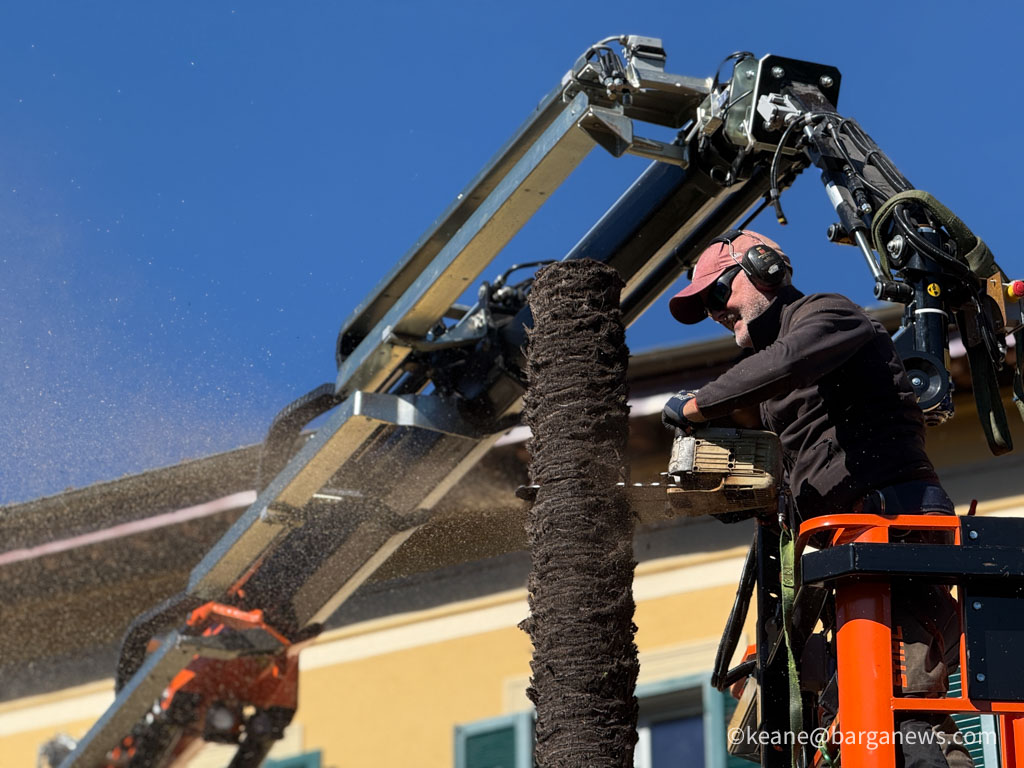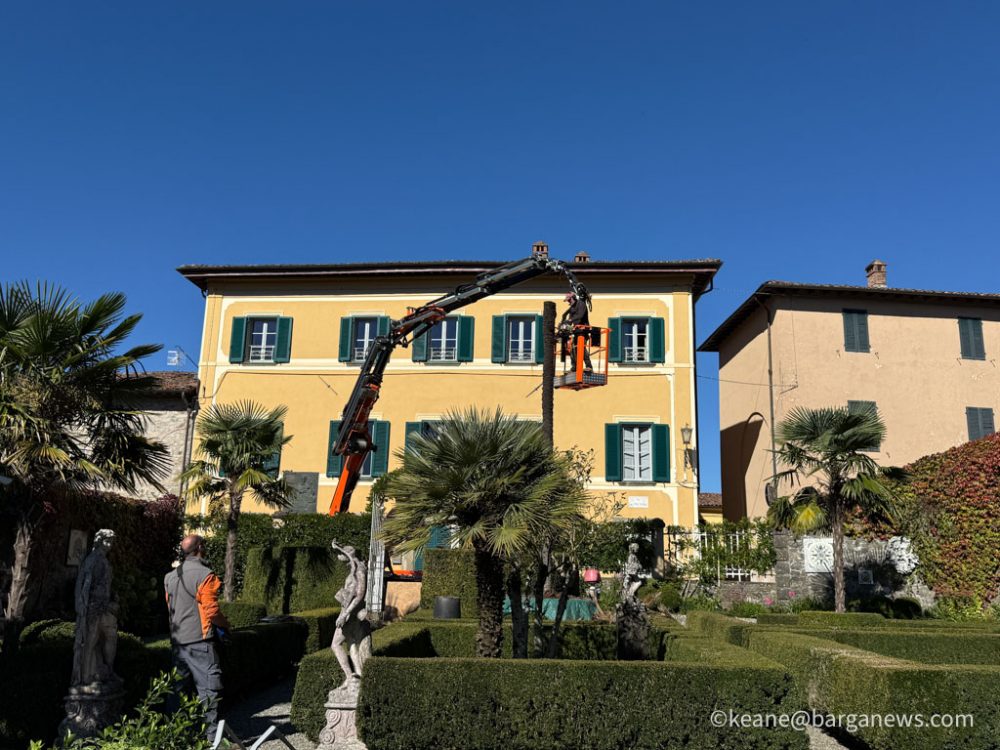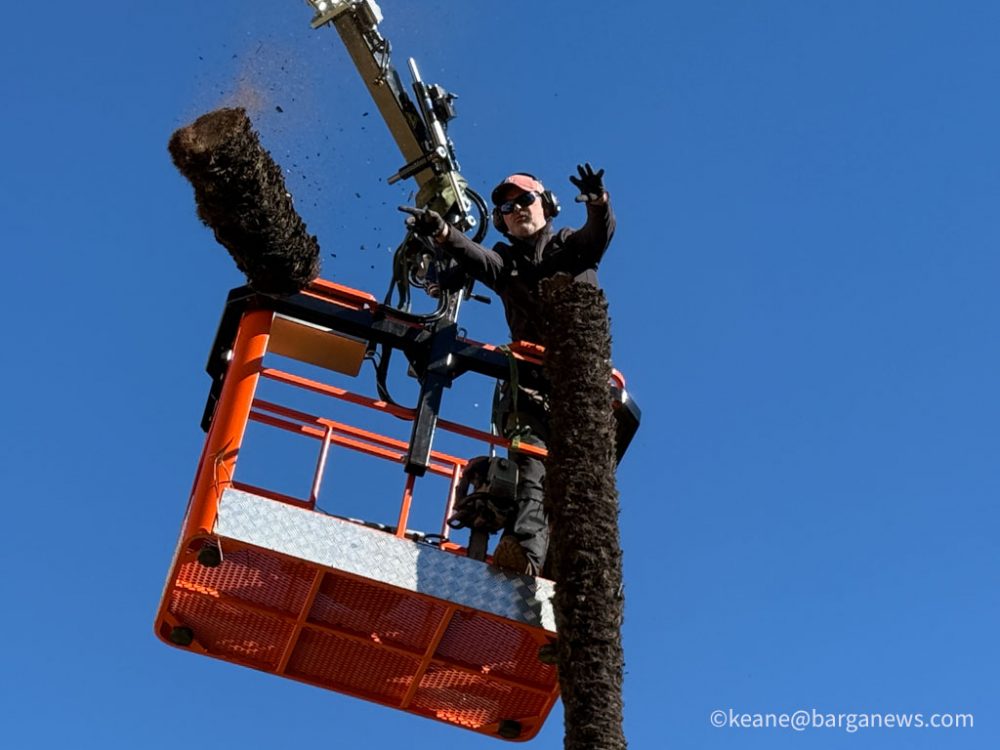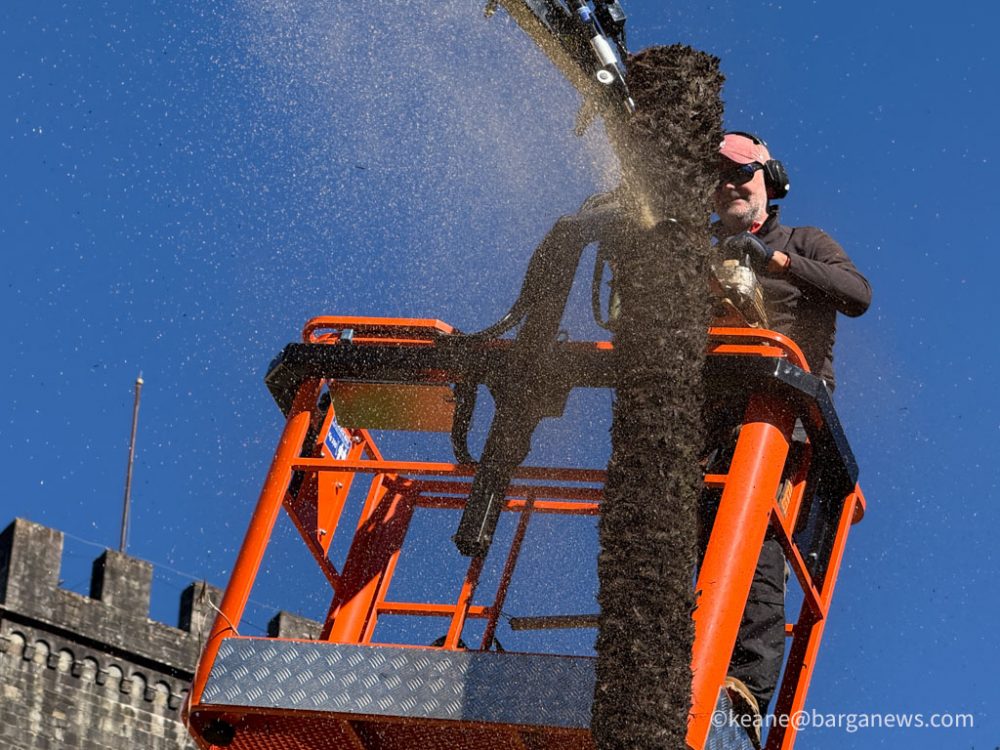Palm Tree Removed Below the Duomo
After Infestation by the Red Palm Weevil The main road leading up to Barga Vecchia and the Duomo was temporarily closed this morning as a mobile crane was brought in to remove a 13-metre-tall palm tree that had been growing in the gardens just below the cathedral.
Over recent months, the tree had been steadily destroyed by the Paysandisia archon, and, for safety reasons, had to be cut down and taken away. Working alone from a raised platform, a tree surgeon used a chainsaw to cut through the decaying wood, and it only took an hour or so to bring the entire tree down.
What had once been a distinctive feature of the garden was reduced to fragments within a few hours.
The Red Palm Weevil (Rhynchophorus ferrugineus), also known as the Asiatic or coconut weevil, is an invasive insect species that has caused severe damage to palm trees across southern Europe. Originating in Southeast Asia, the pest arrived in Europe through imported ornamental palms and has since spread rapidly throughout Mediterranean countries. Italy recorded its first outbreak in 2004, and by 2010, 13 of the country’s 20 regions were affected. The larvae of the weevil are the most destructive stage: they bore deep tunnels into the trunk, feeding on the growing tissues near the crown and ultimately killing the plant by destroying its apical growth area.
New information from Paolo Stefani
It’s not the red palm weevil, a beetle that infests Phoenix palms, but the Paysandisia archon, a diurnal moth that has now devastated all Trachycarpus palms, even in our area. They are completely different insects, and it’s important to clarify. While the red palm weevil has devastated palms in recent years that couldn’t survive due to climate issues in our Barga area, the Paysandisia archon is now destroying centuries-old Trachycarpus palms that have always thrived here—true living monuments…
This morning’s removal serves as a reminder of the ongoing struggle faced by local gardeners and municipalities in combating this invasive species, which continues to threaten the characteristic palms found throughout the Mediterranean landscape.
Rimossa la palma sotto il Duomo dopo l’infestazione della Paysandisia archon La strada principale che sale verso Barga Vecchia e il Duomo è stata temporaneamente chiusa questa mattina per permettere l’intervento di una gru mobile incaricata di rimuovere una palma alta 13 metri, che cresceva nei giardini appena sotto la cattedrale.
Negli ultimi mesi, l’albero era stato progressivamente distrutto dalla Paysandisia archon e, per motivi di sicurezza, è stato necessario abbatterlo e rimuoverlo. L’intervento è stato eseguito da un operatore solitario che, da una piattaforma aerea, ha utilizzato una motosega per tagliare il legno ormai marcio: in poco più di un’ora l’intera palma è stata abbattuta.
Quello che un tempo era un elemento distintivo del giardino è stato ridotto in frammenti nel giro di poche ore.
Il *Punteruolo rosso delle palme* (*Rhynchophorus ferrugineus*), noto anche come punteruolo asiatico o delle noci di cocco, è un insetto invasivo che ha causato gravi danni alle palme in tutto il sud Europa. Originario del Sud-est asiatico, è arrivato in Europa attraverso l’importazione di palme ornamentali e si è rapidamente diffuso in tutti i paesi del Mediterraneo. In Italia il primo focolaio è stato registrato nel 2004 e, entro il 2010, 13 delle 20 regioni italiane risultavano colpite. Le larve del punteruolo rappresentano la fase più distruttiva: scavano gallerie profonde nel tronco, nutrendosi dei tessuti vitali vicino alla corona e uccidendo la pianta distruggendo la sua area di crescita apicale.
Nuove informazioni da Paolo Stefani
Non si tratta del punteruolo rosso, un coleottero che infesta le palme Phoenix, ma della Paysandisia archon, una falena diurna che ha ormai devastato tutte le palme Trachycarpus, anche nella nostra zona. Si tratta di insetti completamente diversi, ed è importante precisarlo. Mentre il punteruolo rosso ha distrutto negli anni scorsi palme che comunque faticavano a sopravvivere nel clima di Barga, la Paysandisia archon sta ora distruggendo le secolari palme Trachycarpus, che da sempre crescevano rigogliose qui — veri e propri monumenti viventi.
L’intervento di questa mattina è dunque un ulteriore promemoria della difficile battaglia che giardinieri e amministrazioni locali stanno affrontando contro questa specie invasiva, che continua a minacciare le caratteristiche palme del paesaggio mediterraneo.










